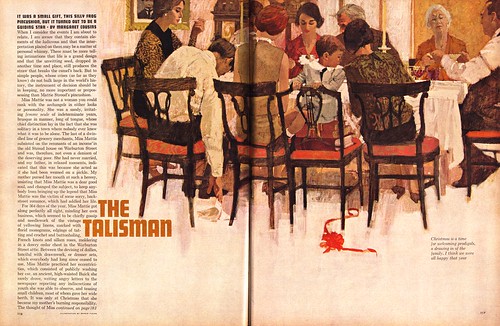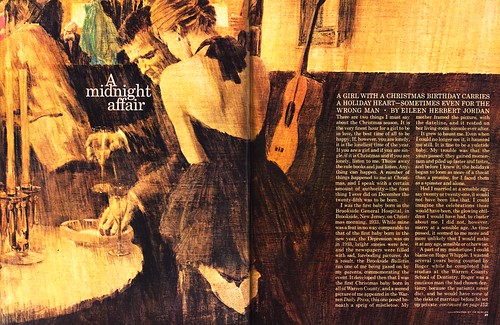
By 1962, magazines were using much less illustration in general, and the type of illustration being used was changing in style in a dramatic way. So this particular issue of McCall's (which contains an abundance of illustration more typical of 1952 than 1962) represents a sort of crossroads of styles and periods.

Today, I'm showing you that issue's contributions by New School artists Bernie Fuchs, Coby Whitmore, and Joe Bowler (respectively). Even within this group we see represented a master originator of that period (Whitmore), a second generation shining star (Bowler), and an architect of the style's next variation, Fuchs, whose unique approach influenced a generation of illustrators for the next decade.

Tomorrow I'll show you the work of the Old School artists from this same issue and on Monday, a look at two masters of the Decorative Style that would dominate illustration during the late 60's and early 70's.
You're on a roll with your post this morning, Lief; looking forward to tomorrow!
ReplyDeleteBob Bollini
I agree with Bob-- I love these comparative analyses, and I am waiting to see where this one is going!
ReplyDeleteThis really hits home. Leif is exactly right about the dramatic change in illustration. When I started art school in 1958, the styles were more like the mid 50's, but the handwriting was defiantly on the wall. "Experiment, do what a photo can't do, let some paint strokes and texture show, loosen up, simplify, make it more impressionistic", were the instructors comments that began to gradually seep into critiques. By 1963, when I left art school. illustration had become a whole different world. Acrylics eclipsed gouache, oils and pastels were more or less ignored in illustration, and a unique style was the only way to get attention. Magazine illustration had declined, and photography was fast becoming king. The challenge was exciting for a young illustrator, but the prospects were a little scary. Versatility and flexibility became the key for me.
ReplyDeleteTom Watson